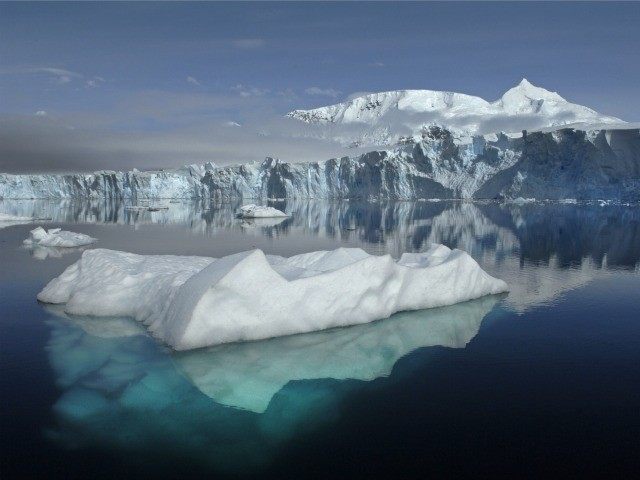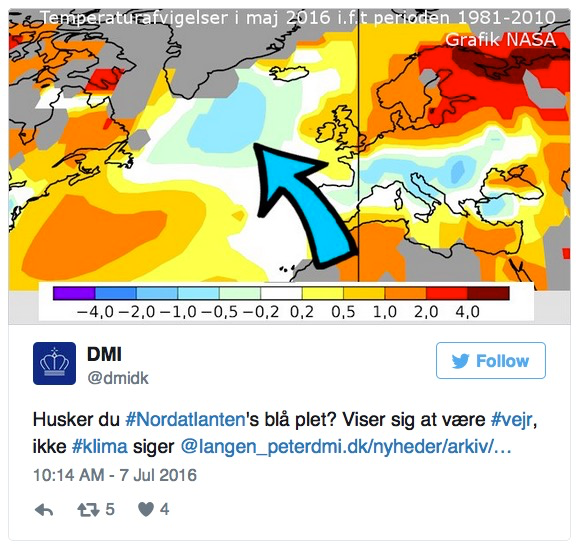A Danish climatologist is pouring cold water over another misleading global warming claim.
Thermographic images released by the National Oceanic and Atmospheric Administration (NOAA) last year showed a mysterious blue blob of cold seawater off the coast of southern Greenland and Iceland. At the time, researchers said the cold blob was likely the result of melting from Greenland’s vast ice sheet, with cold water flowing into the nearby Labrador Sea.
This meltwater was presumed to have slowed the Atlantic Meridional Overturning Circulation (AMOC), or Gulf Stream, that sustains temperate weather in much of western Europe, our East Coast, and the UK.
One of the first researchers at the trough of misinformation was Prof. Michael Mann of Pennsylvania State (and “Hockey Stick” fame), who told the Washington Post that this North Atlantic cold blob happened to fit with his just-published study. Mann also suggested that a “dramatic melting” of Greenland’s ice sheet would slow or stop the AMOC, sending the world into an abrupt climate shift as seen in the climatastrophe flick The Day After Tomorrow.
But Tor Eldevik, a Norwegian climate researcher and professor, subsequently told the newspaper Aftenposten in March 2016 that he was “not convinced that the blue blob was caused by melting Greenlandic ice.” Or that it was slowing the Gulf Stream.
Eldevik said that affecting the AMOC would require vast amounts of freshwater coming into contact with more saline ocean water, which would dramatically change salinity levels and possibly slow the current down. That theory might make sense, Eldevik said, except the currents around Greenland simply aren’t strong enough, or large enough, to slow or stop the Gulf Stream.
Another climate researcher, Peter Langen, showed that this melting Greenlandic ice claim has nothing to do with global warming but rather the result of a particularly cold winter. Dr. Langen, a climatologist at the Danish Meteorological Institute (DMI), said that while Greenland’s coastal areas are melting a little, there simply hasn’t been enough freshwater released to affect the ocean’s circulation in any significant way.
In fact, a year-long study of Greenland’s interior ice sheet showed how very little precipitation is lost via evaporation or melting due to the island’s unique “thermal lid.”
The study, published in Science Advances, illustrates how this unique thermal lid prevents snow and ice from escaping the island, allowing the ice sheet to continuously accumulate in mass. And despite computer climate models claiming Greenland’s ice sheet would be one of the first fatalities in a warming world, this first-of-its-kind study offers convincing evidence that Greenland’s ice sheet remains robust and stable.
Langen also noted that ocean modeling from various studies shows that there simply isn’t enough freshwater being released to influence the Gulf Stream at any great distance from Greenland. After reviewing two new studies, Langen adds that the cold spot seen on NOAA’s map is most likely the result of a simple weather anomaly: an unusually cold winter.
Langen says if the cause of the cold blob was meltwater, it would get mixed and thinned out. The Labrador Sea, which is southwest of Greenland’s southern tip, helps to mix surface and deep ocean water. The saltier the water, the more mixing occurs. If the salinity decreases, so does the mixing. Put simply, the freshwater becomes diluted in such a large area that it is unable to slow or stop oceanic circulation.
Langen adds that the blue blob showed up on NOAA’s maps during the very cold winter of 2014-2015, and the frigid weather actually resulted in increased mixing of surface water with the cold, deep seawater. Langen also explained that researchers reconstructed the cooling of water in the area through complex energy computations, making the weather theory the strongest, and most likely, explanation for the North Atlantic cold blob.
It appears that the cold water observed in the North Atlantic was simply due to a cold winter. And yet, climate alarmists readily attempted to spin it into further proof of global warming. But an analysis of the data shows that, once again, such dramatic claims were overstated.
Thomas Richard is a freelance writer living outside of Boston, MA.


COMMENTS
Please let us know if you're having issues with commenting.